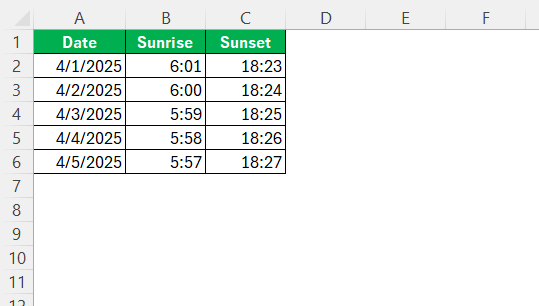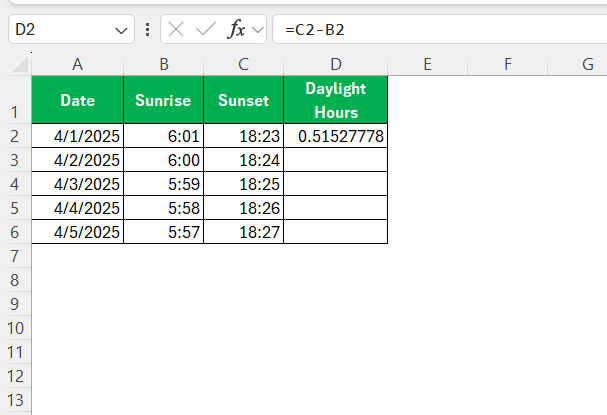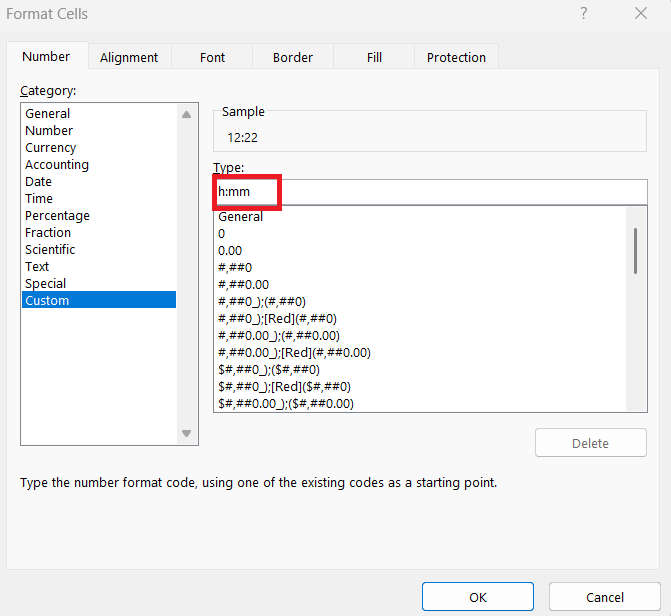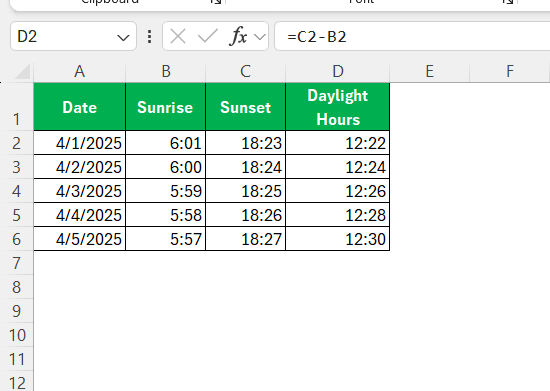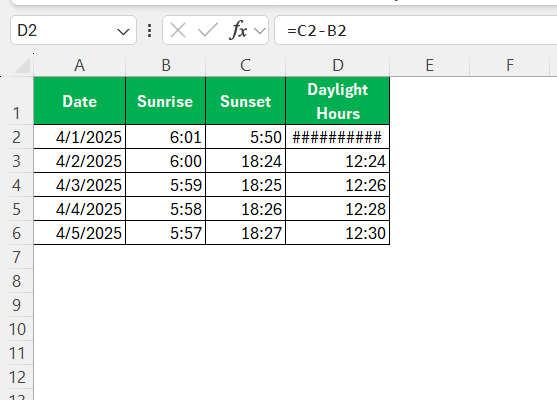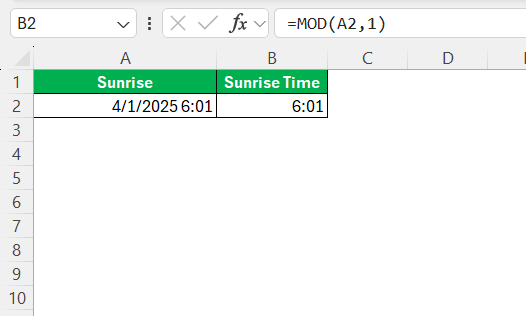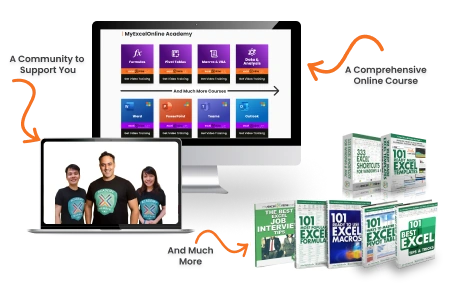Calculating daylight hours, which refers to the time between sunrise and sunset, is essential for various professional and personal activities. This guide explores how to effectively use Excel to compute daylight hours from Sunrise to Sunset, offering a sophisticated Excel process. Whether you’re new to Excel or seeking advanced methods, this guide provides practical insights for optimizing daylight calculations.
Key Takeaways:
- Daylight hours are calculated by subtracting sunrise time from sunset time, best done using Excel’s time formulas.
- Accurate sunrise and sunset definitions rely on the Sun’s position and atmospheric refraction for precise daylight tracking.
- Excel helps users compute daylight efficiently by formatting time cells and applying simple subtraction formulas.
- Common Excel errors like incorrect formats, circular references, and date-time issues can affect daylight calculations.
- Daylight tracking benefits agriculture, event planning, and managing mood disorders like SAD through better light exposure planning.
Table of Contents
Understanding Daylight Hours
Defining Sunrise and Sunset Times
Sunrise and sunset times are pivotal for calculating daylight hours, as they denote the precise moments when the Sun’s upper limb touches the observer’s horizon. These moments account for the atmospheric refraction, which typically sets the Sun at an altitude of -0.833 degrees.
Such measurements are crucial for achieving accurate assessments of daylight intervals and are fundamental in various applications, from agriculture to event planning. Understanding these definitions allows users to ensure precision in tracking the Sun’s daily journey, contributing to more effective time and resource management.
Importance of Calculating Daylight Hours
Calculating daylight hours holds significant importance for both practical and environmental applications. For individuals and industries involved in agriculture, understanding daylight duration aids in optimizing planting schedules and maximizing crop yield by ensuring sufficient exposure to sunlight.
Similarly, businesses like outdoor event planning rely on daylight calculations to enhance scheduling and reduce the need for artificial lighting, thereby saving energy. Furthermore, monitoring these hours benefits those managing Seasonal Affective Disorder, as it assists in planning adequate exposure to natural light, crucial for mood improvement and overall well-being. By accurately tracking daylight, efficiency, and quality of life in numerous areas can be greatly enhanced.
Calculate Daylight Hours from Sunrise to Sunset
To compute daylight duration directly in Excel, utilize simple formulas that subtract the sunrise time from the sunset time. Here’s a step-by-step guide:
STEP 1: In a worksheet, make sure your “Sunrise” column (e.g., B2) and “Sunset” column (e.g., C2) are formatted as time.
STEP 2: In the “Daylight Hours” column (e.g., D2), input the formula =C2-B2. This formula subtracts the sunrise time from the sunset time, giving you the total daylight duration on that day.
STEP 3: Ensure the “Daylight Hours” column is formatted for time. Right-click the cell, select “Format Cells,” and choose “Custom” >> “h:mm” to display hours and minutes without AM or PM.
STEP 4: Drag the fill handle downward to apply the same formula to other rows, calculating daylight hours for multiple dates at once.
This formula offers a simple yet effective way to obtain daily daylight duration, providing a clear visual representation for examination or future analysis.
Troubleshooting Common Errors in Calculations
When working with daylight calculations in Excel, various errors may arise. Understanding and troubleshooting these common issues can significantly improve data accuracy and efficiency.
- Incorrect Time Formatting: Always ensure that sunrise and sunset cells are formatted as “Time.” If daylight duration shows incorrect results, check if the cells are set to the “h:mm” format, accounting for AM/PM appropriately.
- Formula Errors: If errors like “#VALUE!” appear, verify that the formula references are correct and the cells contain expected data types. Reassess the syntax in your formulas, ensuring no typographical errors.
- Circular References: These occur if a formula inadvertently refers back to its cell, causing an infinite loop. Locate circular references by checking under Excel’s “Formulas” tab, then resolve by ensuring that formulas only use necessary cell references and do not refer back to the originating cell inadvertently. Adjust calculations sequentially to prevent such loops.
- Negative results: If sunset is before sunrise (which shouldn’t happen unless there’s a typo), Excel gives a
#####error.
- Date and time in one cell: If your time data includes dates, make sure to extract just the time portion using
=MOD(A2,1).
By addressing these common errors proactively, you can maintain a more robust and reliable daylight calculation system, ensuring the accuracy of your results and the integrity of your data analysis workflows.
Practical Applications of Daylight Calculations
Agriculture and Gardening
In agriculture and gardening, precise calculation of daylight hours is indispensable for optimizing plant growth and productivity. Understanding the length of daylight informs decisions about sowing and harvesting times, ensuring crops receive adequate sunlight, which is vital for photosynthesis and growth cycles. Accurate daylight calculations also help to determine the best time for applying fertilizers or pesticides, as certain conditions are more conducive to their effectiveness.
Gardeners, particularly those working in greenhouse settings, rely on these calculations to control artificial lighting conditions that simulate natural sunlight, promoting healthy plant development year-round. By tailoring plant care routines to exact daylight variations, both commercial farmers and hobbyist gardeners can enhance yields, improve plant health, and reduce energy consumption. This informed approach not only optimizes resource use but also supports sustainable agricultural practices.
Event Planning and Scheduling
In the realm of event planning and scheduling, accurately tracking daylight hours is crucial for creating seamless and well-coordinated events. Whether organizing outdoor weddings, festivals, or sports events, knowing the exact duration of daylight allows planners to optimize scheduling, ensuring critical activities occur during peak light conditions. This minimizes the need for artificial lighting, reducing costs and energy usage.
Moreover, planning around daylight hours enhances guest experience, providing natural light for photography and allowing attendees to enjoy outdoor scenery to its fullest. Safety is another consideration—daylight hours influence decisions on security and logistics, with adequate illumination reducing risks during setup and while guests are arriving or departing. Leveraging Excel to automate and incorporate daylight calculations ensures that planners can quickly adjust schedules and itineraries in response to changing daylight availability throughout the year, ultimately leading to more successful and environmentally conscious events.
Seasonal Affective Disorder Management
Seasonal Affective Disorder (SAD) is a mood disorder that often occurs during periods of reduced sunlight, such as in winter months. Managing SAD involves optimizing exposure to natural light, making the calculation of daylight hours essential for therapeutic scheduling. By knowing the precise start and end times of daylight, individuals and healthcare providers can plan outdoor activities or light therapy sessions at optimal times, ensuring maximum benefit from natural sunlight.
Excel can assist in this management by tracking and predicting daylight variations over time, helping to inform strategies that reduce the disorder’s impact. Patients and caregivers can use these data to adjust daily routines, encouraging more time spent in the open during daylight hours to combat the symptoms of SAD. By leveraging tools that calculate and display shifts in daylight patterns, those affected can better prepare and tailor interventions to enhance mood stability and overall mental wellness.
FAQs
How can I calculate Daylight Hours from Sunrise to Sunset using Excel?
To calculate daylight hours in Excel, subtract the sunrise time from the sunset time using a formula like =C2-B2. Format both columns as time, and apply a custom format like “h:mm” to the result for clear readability. This allows you to see how long the Sun is up each day. You can extend the formula to multiple dates for broader analysis and planning.
What are the benefits of using Excel over manual methods?
Using Excel over manual methods provides accuracy, efficiency, and ease in handling large datasets. It automates calculations, ensuring error-free results, saves time through sophisticated functions and formulas, and allows for quick updates or changes. Excel also offers visualization tools like charts, aiding in the clear representation of data trends, which enhances analytical capabilities.
How can I update my spreadsheet for different locations?
To update your spreadsheet for different locations, adjust the sunrise and sunset data according to the specific geographic coordinates and time zone of the location. You can achieve this by using Excel’s Power Query to import data from online sources or APIs that provide location-specific astronomical data. Modify the parameters in your queries to ensure the imported data reflects the desired area.
What defines sunrise and sunset times in daylight calculations?
Sunrise and sunset are defined as the moments when the Sun’s upper edge just touches the horizon, accounting for atmospheric refraction. Specifically, the Sun is positioned at -0.833 degrees altitude during these times. These definitions are used globally to ensure consistent and accurate daylight measurement. Understanding this helps in precisely determining daylight duration for any given location and date.
Why is calculating daylight hours important?
Calculating daylight hours is crucial for planning activities that depend on natural light, such as agriculture, outdoor events, and mental health treatments. Farmers use it to time planting and harvesting for maximum yield, while event planners rely on it to reduce lighting costs. Additionally, it helps people manage conditions like Seasonal Affective Disorder by scheduling optimal sunlight exposure. Accurate daylight tracking supports better productivity and well-being.
John Michaloudis is a former accountant and finance analyst at General Electric, a Microsoft MVP since 2020, an Amazon #1 bestselling author of 4 Microsoft Excel books and teacher of Microsoft Excel & Office over at his flagship MyExcelOnline Academy Online Course.

